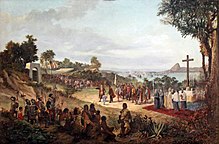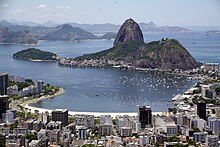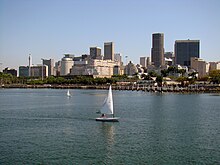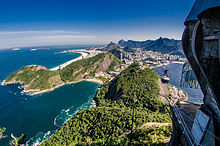Rio de Janeiro is the second most populous municipality in Brazil and the sixth largest city in the Americas. The metropolis is anchor to the Rio de Janeiro metropolitan area, the second most populous metropolitan area in Brazil and seventh most populous in the Americas. Rio de Janeiro is the capital of the state of Rio de Janeiro, Brazil's third most populous state. Part of the city has been designated as a World Heritage Site, named "Rio de Janeiro: Carioca Landscapes between the Mountain and the Sea", by UNESCO on 1 July 2012 as a Cultural Landscape.
Founded in 1565 by the Portuguese, the city was initially the seat of the Captaincy of Rio de Janeiro, a domain of thePortuguese Empire. Later, in 1763, it became the capital of the State of Brazil, a state of the Portuguese Empire. In 1808, when the Portuguese Royal Court transferred itself from Portugal to Brazil, Rio de Janeiro became the chosen seat of the court of Queen Maria I of Portugal, who subsequently, in 1815, under the leadership of her son, the Prince Regent, and future King João VI of Portugal, raised Brazil to the dignity of a kingdom, within the United Kingdom of Portugal, Brazil, and Algarves. Rio stayed the capital of the pluricontinental Lusitanian monarchy until 1822, when the War of Brazilian Independence began. This is one of the few instances in history that the capital of a colonising country officially shifted to a city in one of its colonies. Rio de Janeiro subsequently served as the capital of the independent monarchy, the Empire of Brazil, until 1889, and then the capital of a republican Brazil until 1960 when the capital was transferred to Brasília.
Rio de Janeiro has the second largest municipal GDP in the country, and 30th largest in the world in 2008, estimated at about R$343 billion (IBGE, 2008) (nearly US$201 billion). It is headquarters to Brazilian oil, mining, and telecommunications companies, including two of the country's major corporations—Petrobras and Vale—and Latin America's largest telemedia conglomerate, Grupo Globo. The home of many universities and institutes, it is the second-largest center of research and development in Brazil, accounting for 17% of national scientific output according to 2005 data.
Rio de Janeiro is one of the most visited cities in the Southern Hemisphere and is known for its natural settings, Carnival,samba, bossa nova, and balneario beaches such as Barra da Tijuca, Copacabana, Ipanema, and Leblon. In addition to the beaches, some of the most famous landmarks include the giant statue of Christ the Redeemer atop Corcovadomountain, named one of the New Seven Wonders of the World; Sugarloaf Mountain with its cable car; the Sambódromo(Sambadrome), a permanent grandstand-lined parade avenue which is used during Carnival; and Maracanã Stadium, one of the world's largest football stadiums.
Rio de Janeiro will host the 2016 Summer Olympics and the 2016 Summer Paralympics—the first time a South American and Portuguese-speaking country will host these events, and the third time the Olympics will be held in a Southern Hemisphere city. The Maracanã Stadium held the finals of the 1950 and 2014 FIFA World Cups, the 2013 FIFA Confederations Cup, and the XV Pan American Games including its opening and closing ceremonies. Rio de Janeiro also hosted World Youth Day in 2013.
History
Main articles: History of Rio de Janeiro and Timeline of Rio de Janeiro
Historical affiliations
Europeans first encountered Guanabara Bay on 1 January 1502 (hence Rio de Janeiro, "January River"), by a Portuguese expedition under explorer Gaspar de Lemos captain of a ship in Pedro Álvares Cabral's fleet, or under Gonçalo Coelho.Allegedly the Florentine explorer Amerigo Vespucci participated as observer at the invitation of King Manuel I in the same expedition. The region of Rio was inhabited by the Tupi, Puri, Botocudo and Maxakalí peoples.
In 1555, one of the islands of Guanabara Bay, now called Villegagnon Island, was occupied by 500 French colonists under the French admiral Nicolas Durand de Villegaignon. Consequently, Villegagnon built Fort Coligny on the island when attempting to establish the France Antarctique colony.
The city of Rio de Janeiro proper was founded by the Portuguese on 1 March 1565 and was named São Sebastião do Rio de Janeiro, in honour of St. Sebastian, the saint who was the namesake and patron of the then Portuguese Monarch D. Sebastião. Rio de Janeiro was the name of Guanabara Bay. Until early in the 18th century, the city was threatened or invaded by several, mostly French, pirates and buccaneers, such as Jean-François Duclerc and René Duguay-Trouin.
In the late 17th century, still during the Sugar Era, the Bandeirantes found gold and diamonds in the neighbouring captaincy ofMinas Gerais, thus Rio de Janeiro became a much more practical port for exporting wealth (gold, precious stones, besides the sugar) than Salvador, Bahia, which is much farther to the northeast. On 27 January 1763, the colonial administration in Portuguese America was moved from Salvador to Rio de Janeiro. The city remained primarily a colonial capital until 1808, when the Portuguese royal family and most of the associated Lisbon nobles, fleeing from Napoleon's invasion of Portugal, moved to Rio de Janeiro. The kingdom's capital was transferred to the city, which, thus, became the only European capital outside of Europe. As there was no physical space or urban structure to accommodate hundreds of noblemen who arrived suddenly, many inhabitants were simply evicted from their homes. There was a large influx of African slaves to Rio de Janeiro: in 1819, there were 145,000 slaves in the captaincy. In 1840, the number of slaves reached 220,000 people.
When Prince Pedro proclaimed the independence of Brazil in 1822, he decided to keep Rio de Janeiro as the capital of his new empire. Rio continued as the capital of Brazil after 1889, when the monarchy was replaced by a republic. Until the early years of the 20th century, the city was largely limited to the neighbourhood now known as the historic city centre (see below), on the mouth of Guanabara Bay. The city's centre of gravity began to shift south and west to the so-called Zona Sul (South Zone) in the early part of the 20th century, when the first tunnel was built under the mountains located between Botafogo and the neighbourhood now known as Copacabana. Expansion of the city to the north and south was facilitated by the consolidation and electrification of Rio's streetcar transit system after 1905.Botafogo's natural beauty, combined with the fame of the Copacabana Palace Hotel, the luxury hotel of the Americas in the 1930s, helped Rio to gain the reputation it still holds today as a beach party town (although this reputation has been somewhat tarnished in recent years by favela violence resulting from the narcotics trade). Plans for moving the nation's capital city to the territorial centre had been occasionally discussed, and when Juscelino Kubitschek was elected president in 1955, it was partially on the strength of promises to build a new capital.Though many thought that it was just campaign rhetoric, Kubitschek managed to have Brasília built, at great cost, by 1960. On 21 April that year the capital of Brazil was officially moved from Rio de Janeiro to Brasília.
Between 1960 and 1975, Rio was a city-state under the name Guanabara State (after the bay it borders). However, for administrative and political reasons, a presidential decree known as "The Fusion" removed the city's federative status and merged it with the State of Rio de Janeiro, the territory surrounding the city whose capital was Niterói, in 1975. Even today, some Cariocas advocate the return of municipal autonomy.
The city hosted the 2007 Pan American Games and the 2014 FIFA World Cup final. It was announced on 2 October 2009, that Rio will host the 2016 Olympic Games, beating the finalist competitors Chicago, Tokyo, and Madrid. The city will become the first South American city to host the event and the second Latin American city (afterMexico City in 1968) to host the Games. The city hosted the World Youth Day in 2013, the second World Youth Day in South America and first in Brazil.
Climate
Rio has a tropical savanna climate (Aw) that closely borders a tropical monsoon climate (Am) according to the Köppen climate classification, and is often characterized by long periods of heavy rain from December to March.In inland areas of the city, temperatures above 40 °C (104 °F) are common during the summer, though rarely for long periods, while maximum temperatures above 27 °C (81 °F) can occur on a monthly basis.
Along the coast, the breeze, blowing onshore and offshore, moderates the temperature. Because of its geographic situation, the city is often reached, especially during autumn and winter, by cold fronts advancing from Antarctica, causing frequent weather changes. It is mostly in summer that strong showers provoke catastrophic floods and landslides. The mountainous areas register greater rainfall since they constitute a barrier to the humid wind that comes from the Atlantic.
The city reputedly has had rare frosts in the past, but this has never been decisively confirmed. Some areas within Rio de Janeiro state occasionally have falls of snow grains and ice pellets (popularly called granizo, or "hail", although it is in fact melted and refrozen snow falling in the form of a ball—true hail, rather than just icy snow along showers, is much less common). These phenomena are definitely not rare or limited to a few regions, having already happened in the metropolitan area (including western suburbs of the city itself) several times in the 21st century. In other areas there is true snowfall more than once in each century (the last time this occurred in Rio de Janeiro state was in the mid-1980s), most commonly around the highest mountain in the state (for perhaps centuries thought to be the country's highest) and fifth highest in the country, Pico das Agulhas Negras, in the cities of Resende and Itatiaia (in lower latitudes than Rio de Janeiro, but much higher altitudes).
Elsewhere in the state, drought is very rare, albeit bound to happen occasionally given its strongly seasonal tropical climate. The Brazilian drought of 2014–2015, most severe in the Southeast Region and the worst in decades, affected the entire metropolitan region's water supply (a diversion from the Paraíba do Sul River to the Guandu River is a major source for the state's most populous mesoregion). Plans to divert the Paraíba do Sul to the Sistema Cantareira (Cantareira system) during its water crisis of 2014, in order to help the critically drought-stricken Greater São Paulo area, offered the easiest short-term response to the consequences of climate change and the deforestation of the Amazon rainforest (itself affecting climate change), an issue expected to linger across the entire country in the near future. This will likely make the situation even more complex, however, as sufficient rainfall to supply tap water service to both metropolitan areas in the future is merely speculative.This circumstance, as shown in a recent central government report, is worsened by the fact that 37% of the country's tap water is being lost due to leaky pipes (sometimes resulting in contaminated water), fraud and illegal access, and by the country's use of hydroelectric power as its main energy source.
Roughly in the same suburbs (Nova Iguaçu and surrounding areas, including parts of Campo Grande and Bangu) that correspond to the location of the March 2012, February–March 2013 and January 2015 pseudo-hail (granizo) falls, there was a tornado-like phenomenon in January 2011, for the first time in the region's recorded history, causing structural damage and long-lastingblackouts, but no fatalities. The World Meteorological Organization has advised that Brazil, especially its southeastern region, must be prepared for increasingly severe weather occurrences in the near future, since events such as the catastrophic January 2011 Rio de Janeiro floods and mudslides are not an isolated phenomenon. "This (the early 2010s serial devastation in Rio de Janeiro's mesoregions of Metropolitana do Rio de Janeiro and Sul Fluminense) was not an isolated event. The events in Brazil confirms a global trend that storms tend to be increasingly strong and in places where it did not take place with the same force", said Rupakumar Kolli, WMO expert on climatological phenomena. In early May 2013, winds registering above 90 km/h (56 mph) caused blackouts in 15 neighborhoods of the city and three surrounding municipalities, and killed one person.Rio saw similarly high winds (about 100 km/h (62 mph)) in January 2015.The average annual minimum temperature is 21 °C (70 °F),the average annual maximum temperature is 27 °C (81 °F), and the average annual temperature is 24 °C (75 °F).The average yearly precipitation is 1,069 mm (42.1 in).
Temperature also varies according to elevation, distance from the coast, and type of vegetation or land use. Winter, cold fronts and dawn/morning sea breezes bring mild temperatures; cold fronts, the Intertropical Convergence Zone (in the form of winds from theAmazon Forest), the strongest sea-borne winds (often from an extratropical cyclone) and summer evapotranspiration bring showers or storms. Thus the monsoon-like climate has dry and mild winters and springs, and very wet and warm summers and autumns. As a result, temperatures over 40 °C (104 °F), that may happen about year-round but are much more common during the summer, often mean the actual temperature feeling is over 50 °C (122 °F), when there is little wind and the relative humidity percentage is high.In such weather, avoiding dehydration (by high consumption of water, and if possibly potassium in people not affected by hyperkalemia, and low consumption of sodium), over-exercising and direct exposure to the sun is recommended, especially for children and elders. Rio de Janeiro is second onlyto Cuiabá as the hottest Brazilian state capital outside Northern andNortheastern Brazil; temperatures below 14 °C (57 °F) occur yearly, while those lower than 11 °C (52 °F) happen less often. The phrase, fazer frio ("making cold", i.e. "the weather is getting cold"), usually refers to temperatures going below 21 °C (70 °F), which is possible year-round and is commonplace in mid-to-late autumn, winter and early spring nights.
There is also a slightly greater seasonal difference in the incidence of solar radiation people receive in Rio de Janeiro (or about anywhere else in the Southern Hemisphere) in comparison to places in the Northern Hemisphere with similar climate and the same exact latitude as the Earth most closely approaches Sol (the local Sun) only 12 days after the Southern Hemisphere's summer solstice. See illustration at the article on the Earth's seasons.
Between 1961 and 1990, at the INMET (Brazilian National Institute of Meteorology) conventional station located in the neighborhood of Saúde, the lowest temperature recorded was 10.1 °C (50.2 °F) in October 1977, and the highest temperature recorded was 39 °C (102.2 °F) in December 1963. The highest accumulated rainfall in 24 hours was 167.4 mm (6.6 in) in January 1962.However, the absolute minimum temperature ever recorded at the INMET Jacarepaguá station, 3.8 °C (38.8 °F) in July 1974,while the absolute maximum was 43.2 °C (110 °F) 26 December 2012,in the neighborhood of the Santa Cruz station, while the highest accumulated rainfall in 24 hours, of 186.2 mm (7.3 in) was recorded at theSanta Teresa station in April 1967.The lowest temperature ever registered in the 21st century was 8.1 °C (46.6 °F) in Vila Militar, July 2011.
| [hide]Climate data for Rio de Janeiro[note 1] | |||||||||||||
|---|---|---|---|---|---|---|---|---|---|---|---|---|---|
| Month | Jan | Feb | Mar | Apr | May | Jun | Jul | Aug | Sep | Oct | Nov | Dec | Year |
| Record high °C (°F) | 40.9 (105.6) | 41.8 (107.2) | 41 (106) | 39.3 (102.7) | 36.3 (97.3) | 35.9 (96.6) | 34.9 (94.8) | 38.9 (102) | 40.6 (105.1) | 42.8 (109) | 40.5 (104.9) | 42 (108) | 42.8 (109) |
| Average high °C (°F) | 30.2 (86.4) | 30.2 (86.4) | 29.4 (84.9) | 27.8 (82) | 26.4 (79.5) | 25.2 (77.4) | 25 (77) | 25.5 (77.9) | 25.4 (77.7) | 26 (79) | 27.4 (81.3) | 28.6 (83.5) | 27.3 (81.1) |
| Daily mean °C (°F) | 26.3 (79.3) | 26.6 (79.9) | 26 (79) | 24.4 (75.9) | 22.8 (73) | 21.8 (71.2) | 21.3 (70.3) | 21.8 (71.2) | 22.2 (72) | 22.9 (73.2) | 24 (75) | 25.3 (77.5) | 23.8 (74.8) |
| Average low °C (°F) | 23.3 (73.9) | 23.5 (74.3) | 23.3 (73.9) | 21.9 (71.4) | 20.4 (68.7) | 18.7 (65.7) | 18.4 (65.1) | 18.9 (66) | 19.2 (66.6) | 20.2 (68.4) | 21.4 (70.5) | 22.4 (72.3) | 21 (70) |
| Record low °C (°F) | 17.7 (63.9) | 18.9 (66) | 18.6 (65.5) | 16.2 (61.2) | 11.1 (52) | 8.6 (47.5) | 12.2 (54) | 10.6 (51.1) | 10.2 (50.4) | 10.1 (50.2) | 15.1 (59.2) | 17.1 (62.8) | 8.6 (47.5) |
| Average rainfall mm (inches) | 137.1 (5.398) | 130.4 (5.134) | 135.8 (5.346) | 94.9 (3.736) | 69.8 (2.748) | 42.7 (1.681) | 41.9 (1.65) | 44.5 (1.752) | 53.6 (2.11) | 86.5 (3.406) | 97.8 (3.85) | 134.2 (5.283) | 1,069.4 (42.102) |
| Average rainy days (≥ 1 mm) | 11 | 7 | 8 | 9 | 6 | 6 | 4 | 5 | 7 | 9 | 10 | 11 | 93 |
| Average relative humidity (%) | 79 | 79 | 80 | 80 | 80 | 79 | 77 | 77 | 79 | 80 | 79 | 80 | 79.1 |
| Mean monthly sunshine hours | 211.9 | 201.3 | 206.4 | 181 | 186.3 | 175.1 | 188.6 | 184.8 | 146.2 | 152.1 | 168.5 | 179.6 | 2,181.8 |
Average annual temperature of the sea is 23–24 °C (73–75 °F), from 22 °C (72 °F) in the period July–October to 26 °C (79 °F) in February and March.The dominant ocean current is the warm Brazil Current (as most of elsewhere in the Santos Bight between Santa Catarina and Cabo Frio; the subsurface part of the cold subantarcticMalvinas Current only slightly resurfaces to affect the latter, giving the characteristic semi-arid climate in parts of Arraial do Cabo, the only occurrence of such in the whole state). The wettest and driest months tend to be December and August respectively.
| Jan | Feb | Mar | Apr | May | Jun | Jul | Aug | Sep | Oct | Nov | Dec | Year |
|---|---|---|---|---|---|---|---|---|---|---|---|---|
| 25 °C (77 °F) | 26 °C (79 °F) | 26 °C (79 °F) | 25 °C (77 °F) | 24 °C (75 °F) | 23 °C (73 °F) | 22 °C (72 °F) | 22 °C (72 °F) | 22 °C (72 °F) | 22 °C (72 °F) | 23 °C (73 °F) | 25 °C (77 °F) | 24 °C (75 °F) |












No comments:
Post a Comment